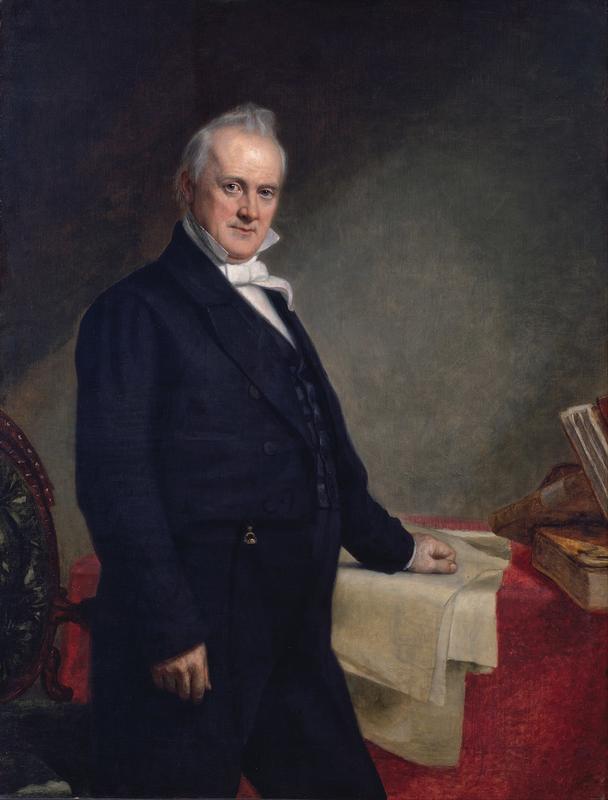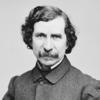More about James Buchanan
- All
- Info
- Shop

Sr. Editor
George Peter Alexander Healy painted more portraits of American presidents than any other artist, but James Buchanan probably takes the cake as the most controversial, arguably having caused the Civil War.
A lawyer by trade, Buchanan rose through the ranks of government as a foreign diplomat, acting as the minister to Russia under President Andrew Jackson, minister to Great Britain under President Franklin Pierce, and secretary of state under President James Polk. Once elected president himself, Buchanan showed none of the same aptitude for governance of the United States.
Buchanan used his influence to sway the Supreme Court to vote, in the historic pro-slavery Dred Scott decision, that African Americans could never be U.S. citizens and that they had no constitutional rights. Furthermore, they ruled that the federal government could not interfere with states' rights by prohibiting slavery in any territory. Buchanan went on to further stoke the flames by attempting, and failing, to bring Kansas into the Union as a slave state. As his one-term presidency came to an end, but before Lincoln was inaugurated (the "lame duck" period), Buchanan did little to prevent the succession of Southern states, nor did he prepare the military for the looming violence. Historians generally agree that these failures make him one of the country's worst and most ineffectual presidents, like, ever. Buchanan was even dubbed a “doughface,” meaning he was a cowardly Northerner who was so pliable (like dough) that he could be convinced to side with Southern interests, especially in regards to slavery.
Interestingly, Buchanan is the United States’ first and only bachelor president, which unsurprisingly caused rumors to fly. Buchanan’s close friendship with politician William Rufus King caused speculation that he was gay, and the two did live together and attend political functions as a pair for the better part of a decade. (Although it should be noted that such a living arrangement was not unusual for the time.) Others theorize that Buchanan was celibate by choice after the death of his fiancee, Anne Caroline Coleman, or that he was simply asexual, though there were rumors of affairs with other women throughout his life.
Unfortunately for Healy, Congress never paid for this portrait of James Buchanan, though they had commissioned it, due to the president's unpopularity. Healy kept the piece, which eventually landed in the hands of H.M. Pierce, whose father was a friend of the artist. It was Pierce who gifted the work to the National Gallery of Art in 1942. The painting was then transferred to the National Portrait Gallery in 1965.
Sources
- Baker, Jean H., James Buchanan: The American Presidents Series: The 15th President, 1857-1861. New York: Time Books, 2004.
- Balcerski, Thomas, “The 175-year history of speculating about President James Buchanan’s bachelorhood,” Smithsonian Magazine, August 27, 2019. Date accessed May 19, 2020. https://www.smithsonianmag.com/history/175-year-history-examining-bache…
- Collier, Gene, “Gene therapy: President’s Day suddenly not so hard on Buchanan’s legacy,” Post-Gazette, February 18, 2020. Date accessed May 19, 2020. https://www.post-gazette.com/opinion/gene-collier-columns/2020/02/18/Tr…
- Cobb, Geoffrey, “Weekly Comment: G.P.A. Healy, the Irish painter of American presidents,” Irish America, February 9, 2018. Date accessed May 19, 2020. https://irishamerica.com/2018/02/weekly-comment-g-p-a-healy-painter-of-…
- Emanuel, Ezekiel, “America has already had a gay president,” Washington Post, March 27, 2019. Date accessed May 19, 2020. https://www.washingtonpost.com/opinions/pete-buttigieg-wouldnt-be-ameri…
- Library of Congress. Manuscript Division, Library of Congress Acquisitions: Manuscript Division. The Library, 1990.
- Loewen, Jim, “We have had a gay president, just not Nixon,” February 22, 2012. Date accessed May 19, 2020. https://historynewsnetwork.org/blog/144754
- Maddux, Jason, “Our 8 worst presidents: where does President Buchanan of Pennsylvania rank on the list?” Penn Live, May 22, 2019. Date accessed May 19, 2020. https://www.pennlive.com/life/2016/02/where_does_president_buchanan.html
- United States, President, Public Papers of the Presidents of the United States, Book 2. Federal Register Division, National Archives and Records Service, General Services Administration, 2008.
- Virginia Museum of Fine Arts, A Souvenir of the Exhibition Entitled Healy's Sitters; Or, A Portrait Panorama of the Victorian Age: Being a Comprehensive Collection of the Likenesses of Some of the Most Important Personages of Europe & America, Volume 571, Issue 15. Richmond, 1950.












